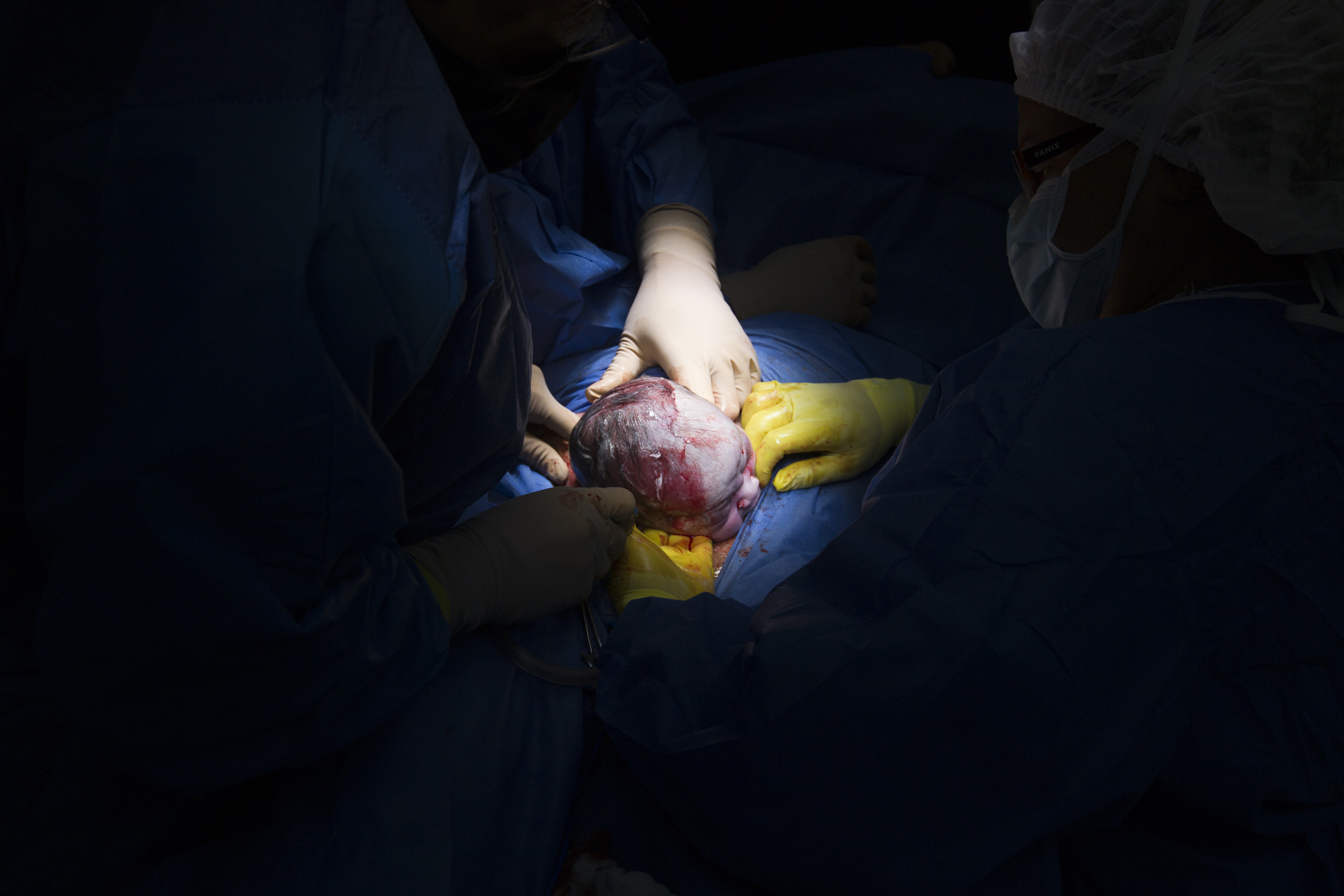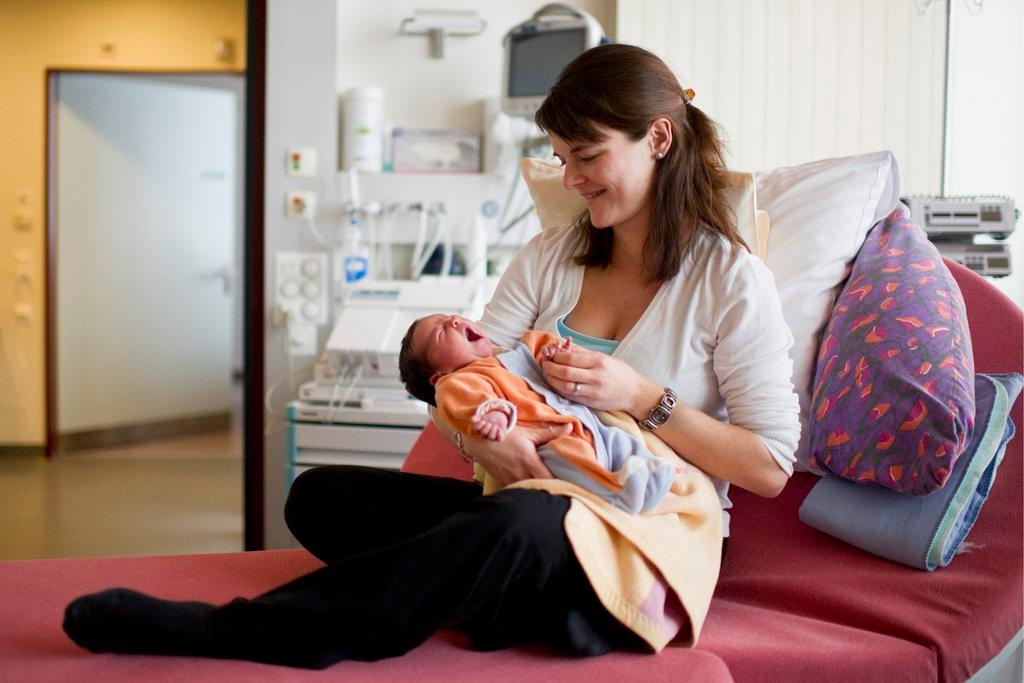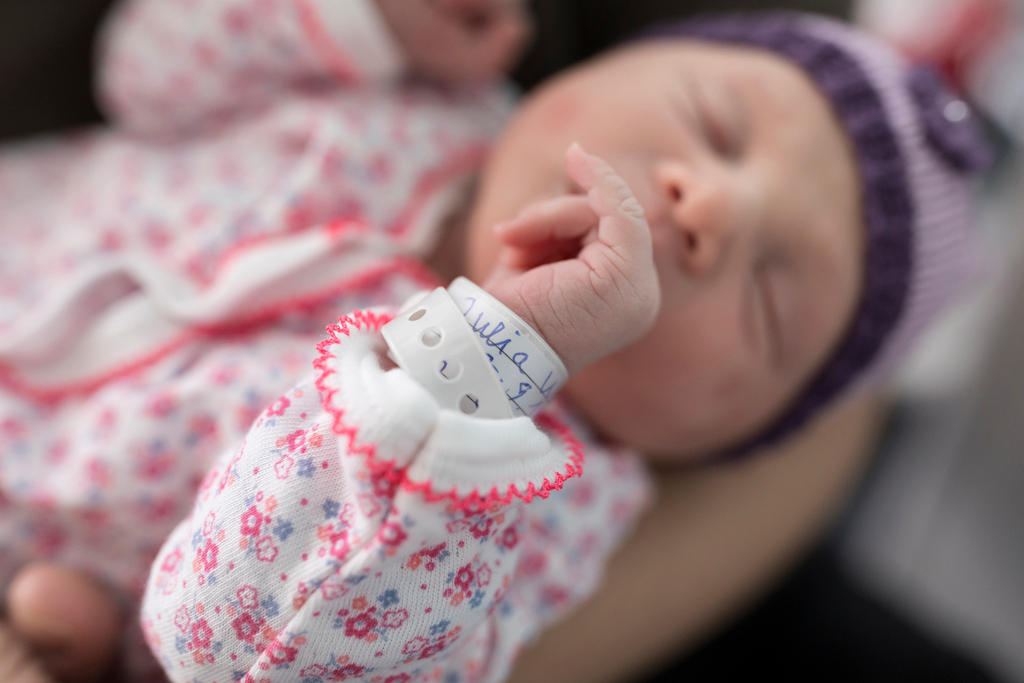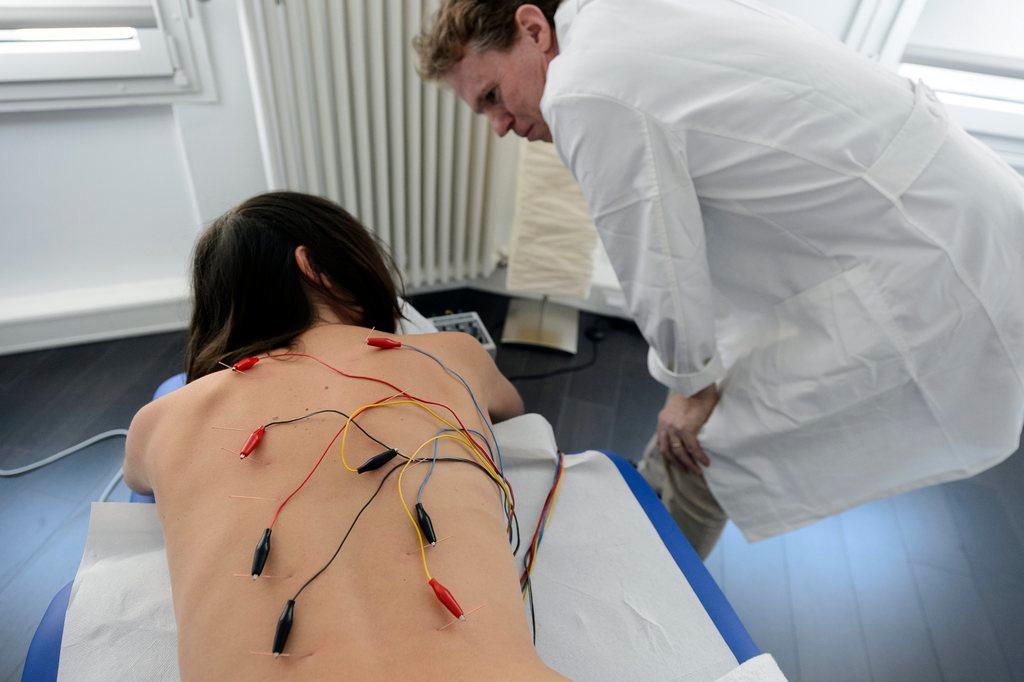The rift between natural birth and on-demand C-sections

When it comes to giving birth in Switzerland, for some women the process can’t be natural enough. Others want a Caesarean section (C-section) from the very early stages of pregnancy without a specific medical need. Both extremes can be problematic.
“Did you give birth naturally or did you have a C-section?” According to a mother from Bern, this is often the first question people ask after delivery and to her, it is clearly a judgement. “Natural is best.”
The Swiss almost wage a religious war when it comes to C-sections versus vaginal delivery. And it’s not the only ideological front surrounding childbirth; the fight between conventional and natural medicine is even tougher.
On the one hand, doctors are quick to interfere with natural births by using oxytocic (used to induce labour), forceps, or by administering a C-section. On the other hand, there is a growing trend towards natural childbirth among parents-to-be as well as midwives.
Many Swiss women are keen to deliver without doctors, hospitals, or technical equipment. Hypnobirthing centres as well as midwife-led deliveries are experiencing a boom in Switzerland (see info box). Some women even water their flower beds with the tub water they gave birth in; others bury their placenta in their garden and plant a tree on it. That is if they haven’t already eaten it themselves.
This development is part of a wider trend away from conventional medicine and towards natural lifestyles, homeopathy, and alternative medicine, which is currently spreading across the nation, especially in German-speaking parts of Switzerland.
“If women lean towards the left politically or have alternative viewpoints, they want to give birth ‘naturally’ or ‘spontaneously’ no matter what,” observes a mother from canton Zurich. According to a midwife interviewed by swissinfo.ch, natural deliveries are particularly popular among educated women.
Dangerous trend
Another midwife from canton Zurich finds that Swiss couples particularly prefer natural childbirth, which she believes is due to an appreciation of nature. “It can happen that even though we strongly recommend a C-section, the couple doesn’t want to go along with it,” she says. In most cases things work out, but sometimes they don’t. “It’s difficult for all parties involved. We as experts worry that we did not insist strongly enough on the need, and the parents are shocked because their new-born ends up in the neonatal ward with suspected brain damage.” In such situations, the trend towards natural birth can be dangerous.
And according to the midwife, these are not isolated cases. “Some parents desperately want to experience natural childbirth, but sometimes their child ends up disabled. This is selfish,” she says. “In some cases, we are forced to act against the parents’ wishes and do a C-section whether they like it or not, which is tough.” These situations are not easy for her. She finds it hard to look the parents in the eyes.
Proud midwives
There are also cases of midwives insisting on natural deliveries. “It’s a matter of honour to deliver a baby without medical interventions or painkillers, especially among older midwives,” says Dayo Oliver, a midwife at the Horgen Lake Hospital in Canton Zurich. She says that mothers have shared stories of midwives who delayed giving them painkillers until it was too late.
Barbara Stocker, president of the Swiss Midwives’ Association, agrees. She says that in the 1990s, the use of epidurals was considered a midwife’s failure. As a matter of fact, it’s still considered a point of pride among midwives to carry out a delivery with as little technical equipment as possible. “As a midwife, I sometimes had the feeling that the only reason a woman needed an epidural was because I didn’t have enough time to support her,” she explains.
Sex over children – a taboo
It’s not only natural birth that is trendy. As in neighbouring Germany, there is almost a mother cult among Swiss women, at least in the German-speaking parts. A mother is supposed to sacrifice herself for her child and accept the downsides.
“Nobody tells you before delivery that your sex drive is not the same after a vaginal birth,” a mother from Zurich says. This was one reason why the mother opted for a C-section. “It’s frowned upon to say this out loud as this would put sex above the child,” she says. But sex is a part of a relationship that shouldn’t be neglected. “I want to stay together with my partner, also for the children!”
Mothers opting for an elective C-section often feel they have to justify their decision to others in Switzerland or be labelled selfish. However, how widespread is the phenomenon of ‘too posh to push’ in Switzerland? “I don’t actually know many mothers who had a C-section by choice,” says a mother from Bern.

More
C-section rates create a stir
How common are C-sections on demand?
There are no statistics on elective C-sections in Switzerland. In some hospitals, 1 to 3% of pregnant women opt for a C-section, which means they have surgery without any medical, psychological, or obstetrical reasons.
It is difficult to single out cases of women choosing to have a C-section as a personal preference. But some women may claim that they are scared to have a vagina delivery, which would count as a psychological reason.
According to Dayo Oliver, it is relatively common for expats to opt for a C-section. For many of them it’s all about planning. The father doesn’t want to be in an important meeting when his wife is in labour. If the only reason for a C-section is planning the due date, it is considered an elective C-section.
However, C-sections on demand are not actually that widespread in Switzerland. On the contrary, most Swiss women struggle with the idea. “Some women really want to deliver naturally,” says a mother. “Many women are disappointed when they need to have a C-section as they feel that they have failed,” midwife Oliver confirms.
Medicalisation of childbirth
Why are there concerns about a high rate of C-sections even though most mothers don’t actually want one?
Firstly, the figures have to be put in perspectiveExternal link (in German). The number of C-sections in Switzerland doubled in the past decade to about one third of all deliveries, which is relatively high compared to other OECD countries and higher than the rate recommended by the World Health Organization (WHO).
However, there are many other nations with much higher rates. In the Dominican Republic, Brazil, Egypt, and Turkey, for example, the C-section rate is higher than 50%.
In addition, the statistics show that 10 to 30% of all C-sections in Switzerland are due to “absolute reason”, which means they are done to save the lives of the mother and child. This happens for example when the baby lies horizontally, the mother is HIV-positive, or the placenta is in front of the cervix. In these cases, C-sections are not controversial.
About 70 to 90% of all C-sections are performed for so-called relative reasons, such as multiple births or breech deliveries. Apart from C-sections on demand, the other controversial C-sections are those during deliveries that started off vaginally. Some 50% of all C-sections are due to “prolonged birth and foetal distress,” which means there was obstructed labour, or the baby had an irregular heartbeat. Many affected women and midwives believe that some of these C-sections are unnecessary and woman giving birth should have been given more time.
According to the Federal Office of Public Health, international studies confirm a correlation between the medicalisation of pregnancies and births and the increase in C-sections. In Switzerland, midwives lament that most pregnancy check-ups are carried out by gynaecologists. How the medicalisation of obstetrics came about will be addressed in the next article.
How do women give birth in other countries? Share your knowledge on trends and developments by leaving a comment on our page.
Doula: The US trend of birth companions is slowly gaining popularity in Switzerland. A doula stays with the woman before, during, and after childbirth, providing emotional support and physical help if needed. This is especially important as midwives and doctors often change due to their different shifts. Women opting for a doula have to bear the costs themselves as doula services are not covered by health insurance in Switzerland.
Hypnobirthing: Self-hypnosis using visualisations and deep breathing aims to alleviate pain, making for an easier delivery. This method originating in the US has recently become more popular in Switzerland.
Storing umbilical cord blood: In recent years, private companies have displayed leaflets in Swiss hospitals and gynaecologists’ practices offering to freeze and store umbilical cord blood for a fee. The idea behind it is that the cord blood can help find new stem cell treatments in the future.
Water births: Water births have existed in Switzerland since the 1990s. They enjoy growing popularity as water is said to alleviate pain and ease childbirth.
Midwife-led deliveries: An increasing number of Swiss women want to deliver with the exclusive support of a midwife, without the presence of a doctor. For this reason, more hospitals in Switzerland are offering this as an option. Midwife-led deliveries are performed at the women’s clinic of the Inselspital in Bern or in Zurich’s Stadtspital Triemli. Some hospitals in Basel have also followed suit. The Aarau cantonal hospital has set up two birthing rooms in a small house located in the hospital park. The atmosphere is more like home than a hospital ward and deliveries are assisted exclusively by midwives without medical supervision.
Freelance midwives: Freelance midwives are so popular that it is hard to find one available in Switzerland. Many women want a midwife who will be there during the whole delivery, which is one of the attractions of hiring a freelance midwife.
Birth centres: Giving birth in a comfortable, home-like rather than clinical atmosphere in specially-designed birth centres enjoys growing popularity in Switzerland. In 2016, 1,769 babies were born in such centres – some 70% of all non-clinical deliveries and almost 2% of the total number of deliveries in Switzerland. In some cantons, these birth centres are even included on the hospital list, which means they are reimbursed by health insurance.
Translated from German by Billi Bierling

In compliance with the JTI standards
More: SWI swissinfo.ch certified by the Journalism Trust Initiative














You can find an overview of ongoing debates with our journalists here . Please join us!
If you want to start a conversation about a topic raised in this article or want to report factual errors, email us at english@swissinfo.ch.